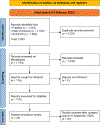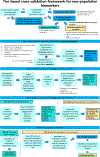Current state and future perspectives on de facto population markers for normalization in wastewater-based epidemiology: A systematic literature review
- PMID: 38761943
- PMCID: PMC11270913
- DOI: 10.1016/j.scitotenv.2024.173223
Current state and future perspectives on de facto population markers for normalization in wastewater-based epidemiology: A systematic literature review
Abstract
Wastewater-based epidemiology (WBE) and wastewater surveillance have become a valuable complementary data source to collect information on community-wide exposure through the measurement of human biomarkers in influent wastewater (IWW). In WBE, normalization of data with the de facto population that corresponds to a wastewater sample is crucial for a correct interpretation of spatio-temporal trends in exposure and consumption patterns. However, knowledge gaps remain in identifying and validating suitable de facto population biomarkers (PBs) for refinement of WBE back-estimations. WBE studies that apply de facto PBs (including hydrochemical parameters, utility consumption data sources, endo- and exogenous chemicals, biological biomarkers and signalling records) for relative trend analysis and absolute population size estimation were systematically reviewed from three databases (PubMed, Web of Science, SCOPUS) according to the PRISMA guidelines. We included in this review 81 publications that accounted for daily variations in population sizes by applying de facto population normalization. To date, a wide range of PBs have been proposed for de facto population normalization, complicating the comparability of normalized measurements across WBE studies. Additionally, the validation of potential PBs is complicated by the absence of an ideal external validator, magnifying the overall uncertainty for population normalization in WBE. Therefore, this review proposes a conceptual tier-based cross-validation approach for identifying and validating de facto PBs to guide their integration for i) relative trend analysis, and ii) absolute population size estimation. Furthermore, this review also provides a detailed evaluation of the uncertainty observed when comparing different de jure and de facto population estimation approaches. This study shows that their percentual differences can range up to ±200 %, with some exceptions showing even larger variations. This review underscores the need for collaboration among WBE researchers to further streamline the application of de facto population normalization and to evaluate the robustness of different PBs in different socio-demographic communities.
Keywords: De facto population; Dynamic population normalization; Population biomarker; Uncertainty analysis; Wastewater-based surveillance.
Copyright © 2024 Elsevier B.V. All rights reserved.
Conflict of interest statement
Declaration of competing interest The authors declare that they have no known competing financial interests or personal relationships that could have appeared to influence the work reported in this paper.
Figures



Similar articles
-
Behavioral interventions to reduce risk for sexual transmission of HIV among men who have sex with men.Cochrane Database Syst Rev. 2008 Jul 16;(3):CD001230. doi: 10.1002/14651858.CD001230.pub2. Cochrane Database Syst Rev. 2008. PMID: 18646068
-
Surveillance of Barrett's oesophagus: exploring the uncertainty through systematic review, expert workshop and economic modelling.Health Technol Assess. 2006 Mar;10(8):1-142, iii-iv. doi: 10.3310/hta10080. Health Technol Assess. 2006. PMID: 16545207
-
Systemic pharmacological treatments for chronic plaque psoriasis: a network meta-analysis.Cochrane Database Syst Rev. 2021 Apr 19;4(4):CD011535. doi: 10.1002/14651858.CD011535.pub4. Cochrane Database Syst Rev. 2021. Update in: Cochrane Database Syst Rev. 2022 May 23;5:CD011535. doi: 10.1002/14651858.CD011535.pub5. PMID: 33871055 Free PMC article. Updated.
-
[Volume and health outcomes: evidence from systematic reviews and from evaluation of Italian hospital data].Epidemiol Prev. 2013 Mar-Jun;37(2-3 Suppl 2):1-100. Epidemiol Prev. 2013. PMID: 23851286 Italian.
-
Wastewater-based epidemiology of influenza viruses: a systematic review.Sci Total Environ. 2025 Jul 15;986:179706. doi: 10.1016/j.scitotenv.2025.179706. Epub 2025 May 30. Sci Total Environ. 2025. PMID: 40449348 Review.
Cited by
-
Wastewater-Based Epidemiological Surveillance in France: The SUM'EAU Network.Microorganisms. 2025 Jan 26;13(2):281. doi: 10.3390/microorganisms13020281. Microorganisms. 2025. PMID: 40005648 Free PMC article.
-
Advances in Wastewater-Based Epidemiology for Pandemic Surveillance: Methodological Frameworks and Future Perspectives.Microorganisms. 2025 May 21;13(5):1169. doi: 10.3390/microorganisms13051169. Microorganisms. 2025. PMID: 40431340 Free PMC article. Review.
-
Comparative Assessment of Wastewater-Based Surveillance Normalization Methods to Improve Pathogen Monitoring in Rural Sewersheds.Environ Sci Technol. 2025 Jun 10;59(22):11095-11107. doi: 10.1021/acs.est.4c14485. Epub 2025 May 26. Environ Sci Technol. 2025. PMID: 40420392 Free PMC article.
-
Evaluating Population Normalization Methods Using Chemical Data for Wastewater-Based Epidemiology: Insights from a Site-Specific Case Study.Viruses. 2025 May 4;17(5):672. doi: 10.3390/v17050672. Viruses. 2025. PMID: 40431684 Free PMC article.
References
-
- Choi P, Tscharke B, Donner E, O’Brien J, Grant S, Kaserzon S, et al. Wastewater-based epidemiology biomarkers: Past, present and future. TRAC-TRENDS IN ANALYTICAL CHEMISTRY. 2018. Aug;105:453–69.
-
- Baker DR, Barron L, Kasprzyk-Hordern B. Illicit and pharmaceutical drug consumption estimated via wastewater analysis. Part A: Chemical analysis and drug use estimates. Science of The Total Environment. 2014. Jul 15;487:629–41. - PubMed
-
- Castiglioni S, Bijlsma L, Covaci A, Emke E, Hernández F, Reid M, et al. Evaluation of Uncertainties Associated with the Determination of Community Drug Use through the Measurement of Sewage Drug Biomarkers. Environ Sci Technol. 2013. Feb 5;47(3):1452–60. - PubMed
Publication types
MeSH terms
Substances
Grants and funding
LinkOut - more resources
Full Text Sources

